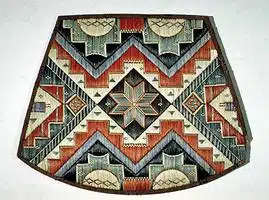Before settlers and colonizers brought glass beads from Czechoslovakia and Italy to North America and added to the seeds that Native Americans beaded with, those indigenous people cultivated a remarkable beauty making skill with braiding, stitching, plaiting, and folding porcupine quills as not only adornment but also as a sign of their bindedness to their land.
Quilling involves removing quills from a dead porcupine. Only certain quills are used from the animal not too thin not too thick. The animal is skinned the skin is tacked to dry then cut into the strips where the long strips can be bent making it easier to pull the quills off. Traditionally the quills are sorted and washed and then dyed with natural sources such as flower petals and plant roots.
While the Mi’kmaq of Quebec and Maine are sometimes called People of the Porcupine, quilling happened all over the continent that is called Turtle Island.
But there is a Lakota story (and there are different versions of this) that tells of an ancient woman, more wrinkled than a walnut, as old as the wind that blows over the hills where she lives and lives there still. This snow capped mountain of a woman has been making a blanket strip out of porcupine quills for her buffalo robe for thousands of years. Maybe longer than that.
Beside her sits her faithful dog, the huge and black Shunka Sapa who watches this eldress carefully and devotedly.
Now when her big earthen pot that holds the sweet berry soup wojapi sits on the fire it sometimes needs a stir. She creaks her old bones up and slowly makes her way to the pot. And in that slow moment when her back is turned Shunka Sapa gnaws on the quills pulling them out of the blanket strip undoing some of the work that had been done and ruining some of the quills.
And in this way she never makes deep progress and has to gather more quills and prepare them and get back to stitching the quills.
But it is said that if this weaving ever gets finished by the old woman that the world will end. So the giant black Shunka Sapa and the porcupine and the old woman and the berries and the pot and the fire and the burning wood all have a part to play in the maintenance of the world.
Here at Primal Derma we appreciate stories like this because it points to a memory and and understanding of how the animal world is linked to the well-being of the world and how endings are part of it. Must be part of it.
Pray you are finding some beauty from the non-human world in your corner of the world that is giving you life.
If you need any Primal Derma to give some life to your skin…we’d love to send you some!

